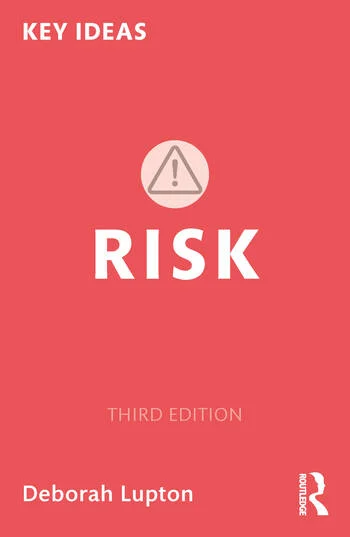The third revised edition of my book Risk, first published in 1999, and second edition published in 2013, is now out. The book has been extensively revised and expanded to take account of the risks that have emerged over the past decade.
A link to the book on Routledge’s website is here and the Google Books preview is here.
Below is the Preface I wrote for the third edition.
In the 1990s and into the early years of the twenty-first century, risk was a key word in both public forums and academic research. The word ‘risk’ was used across social domains and institutions. The sociocultural and political aspects of risk and identifying the reasons for this intensification on risk identification, communication and management were a major preoccupation in the social sciences. The release in 1992 of the English translation of the German sociologist Ulrich Beck’s book Risk Society: Towards a New Modernity was one of the initial impetuses for this academic focus. Simultaneously, however, the scholarship of French philosopher and historian Michel Foucault on the care of the self and the governance of populations, and that of British social anthropologist Mary Douglas on the symbolic dimensions of risk cultures began to be taken up by social researchers and theorists. Their writings were extensively used by others exploring the reasons for why risk had become such a vibrant concept and discussing the implications for social identities, group membership and the management and control of diverse societies.
I wrote the first edition of Risk, published in 1999, for Routledge’s Key Ideas series. In the book, I laid out a schema in which I categorised the Beck approach as ‘the risk society’ perspective, Foucauldian insights as ‘the governmentality’ perspective and Douglas’ scholarship as ‘the cultural/symbolic’ approach. I elaborated on each of these three perspectives and provided examples of how they had been applied to empirical investigations into risk-related understandings and practices. The second revised edition of Risk came out in 2013. In updating the book, I added discussion of some additional theoretical perspectives, discussed some topics that had newly been labelled as risks and included findings from empirical studies that had been conducted since the first edition was published.
It is now a quarter of a century since the first edition of Risk appeared. Over this time, I have noticed that the topic of risk has gradually taken a back seat in social and cultural theory and research, despite its continuing salience to major problems and crises across the world. There have been various ‘turns’ emerging in theory over this time that in some ways have supplanted the ‘risk turn’. The ‘affect turn’ and the ‘materialism turn’ are two key developments. Some scholars have attempted to bring these bodies of theory together by examining the affective or sociomaterial dimensions of risk. However, thus far, this scholarship has largely remained on the fringes of risk research.
In revising Risk for its third edition, I therefore thought it important to make a strong call for a ‘re-turn’ to sociocultural risk theory in a way that incorporates insights from these theoretical developments and addresses the latest catastrophes besetting the world. At the time of writing, the world is faced with frightening disasters and emergencies. The Russian invasion of Ukraine that commenced in early 2022 continues unabated, with no clear end in sight, while the crisis affecting displaced people in other nations such as Syria, Venezuela, South Sudan and Afghanistan continues to create hardship, poor health and uncertainty for these groups. The COVID-19 crisis, confirmed as a pandemic by the World Health Organization in March 2020, is still raging globally. Citizens of the world’s most populous country, China, are facing rapid spread of the disease for the first time, following its leaders’ decision to drop many of the strong prevention strategies that have successfully controlled the outbreak in that nation. The climate emergency and associated risks of environmental degradation, loss of biodiversity, emerging diseases affecting humans and other animals, and devastating natural disasters such as wildfires, floods, droughts and landslides has yet to be properly addressed by governments, national leaders and peak global organisations. There are global food and fuel shortages triggered by the war in Ukraine, other disruptions in supply chains due to the COVID emergency, and many nations face an economic recession and severe cost of living crises.
Together, these emergencies appear so intractable and unsettling as to be labelled as constituting a ‘permacrisis’: a term chosen as Collins Dictionary’s word of the year for 2022. Yet we are living in a world in which the existence of risk is constantly debated, misinformation and disinformation are rife and spread quickly and easily through online media, and where governments and institutions continue to avoid taking decisive action even when there is general agreement that a serious threat exists. Understanding how people, social groups and social organizations understand, respond to and act on threats, hazards and dangers is more important than ever. This third edition has been updated to confront these issues, including the addition of an entirely new chapter that focuses on risk misinformation, scepticism and denial, using the climate and COVID-19 crises as case studies.
